| Revision as of 00:14, 30 October 2015 editFroid (talk | contribs)Extended confirmed users75,352 edits →Origin: Adding/improving reference(s)← Previous edit | Revision as of 00:23, 30 October 2015 edit undoFroid (talk | contribs)Extended confirmed users75,352 edits →In North America: Adding/improving reference(s) Copyedit (major)Next edit → | ||
| Line 25: | Line 25: | ||
| ===In North America=== | ===In North America=== | ||
| Adaptations of ]'s |
Adaptations of ]'s short story "]" (1820) often depict the ] with a pumpkin or jack-o'-lantern in place of his severed head. (In the original story, a shattered pumpkin is discovered next to ]'s abandoned hat on the morning after Crane's supposed encounter with the Horseman.) | ||
| The application of the term to carved pumpkins in American English is first attested in 1834.<ref> |
The application of the term to carved pumpkins in American English is first attested in 1834.<ref>{{cite news|title=Jack-o'-lantern|work=Oxford English Dictionary}} The earliest citation is from 1663.</ref> The carved pumpkin lantern's association with Halloween is recorded in the 1 November 1866 edition of the ''Daily News'' (]): | ||
| {{cquote|The old time custom of keeping up Hallowe'en was not forgotten last night by the youngsters of the city. They had their maskings and their merry-makings, and perambulated the streets after dark in a way which was no doubt amusing to themselves. There was a great sacrifice of pumpkins from which to make transparent heads and face, lighted up by the unfailing two inches of tallow candle.<ref> |
{{cquote|The old time custom of keeping up Hallowe'en was not forgotten last night by the youngsters of the city. They had their maskings and their merry-makings, and perambulated the streets after dark in a way which was no doubt amusing to themselves. There was a great sacrifice of pumpkins from which to make transparent heads and face, lighted up by the unfailing two inches of tallow candle.<ref>{{cite news|work=Daily News|location=Kingston, Ontario|date= November 1, 1866|title=Carved pumpkin}}</ref>}} | ||
| ] wrote a ] |
] wrote a ] titled ''The Jack O'lantern (le Feu-Follet), Or the Privateer'' (1842). ''The Jack O'lantern'' was the name of the ship.<ref>{{cite news|url=http://archive.spectator.co.uk/article/3rd-december-1842/14/coopers-jack-olanternle-peu-pollet |title=Review of Cooper's 'Jack O'Lantern'|work=The Spectator|date= December 3, 1842}}</ref> | ||
| Agnes Carr Sage, |
Agnes Carr Sage wrote, in the article, ''Halloween Sports and Customs" ('']'' (1885):<ref>{{author=Sage, Agnes Carr|title=Halloween Sports and Customs|work=]|date= October 27, 1885|page=828}}</ref>: | ||
| {{cquote|It is an ancient British custom to light great bonfires (Bone-fire to clear before Winter froze the ground) on Hallowe'en, and carry blazing fagots about on long poles; but in place of this, American boys delight in the funny grinning jack-o'-lanterns made of huge yellow pumpkins with a candle inside.}} | {{cquote|It is an ancient British custom to light great bonfires (Bone-fire to clear before Winter froze the ground) on Hallowe'en, and carry blazing fagots about on long poles; but in place of this, American boys delight in the funny grinning jack-o'-lanterns made of huge yellow pumpkins with a candle inside.}} | ||
| The poet ], who was born in Massachusetts in 1807, wrote "The Pumpkin" (1850):<ref>Whittier, John Greenleaf |
The poet ], who was born in Massachusetts in 1807, wrote the poem "The Pumpkin" (1850):<ref>{{cite web|author=Whittier, John Greenleaf|url=http://www.poets.org/viewmedia.php/prmMID/19022 |website=Poets.org|title=The Pumpkin|date=1885}}</ref> | ||
| {{cquote|Oh!—fruit loved of boyhood!—the old days recalling,<br> | {{cquote|Oh!—fruit loved of boyhood!—the old days recalling,<br> | ||
| When wood-grapes were purpling and brown nuts were falling!<br> | When wood-grapes were purpling and brown nuts were falling!<br> | ||
| Line 42: | Line 41: | ||
| Glaring out through the dark with a candle within!}} | Glaring out through the dark with a candle within!}} | ||
| In the United States, the carved pumpkin was first associated with the harvest season in general, long before it became an emblem of Halloween.<ref name=NYTM/> In 1900, an article on Thanksgiving entertaining recommended a lit jack-o'-lantern as part of the festivities.<ref name=NYTM> |
In the United States, the carved pumpkin was first associated with the harvest season in general, long before it became an emblem of Halloween.<ref name=NYTM/> In 1900, an article on Thanksgiving entertaining recommended a lit jack-o'-lantern as part of the festivities.<ref name=NYTM>{{cite news|url=http://query.nytimes.com/gst/abstract.html?res=9800EEDC1139E033A25757C2A9679D94649ED7CF |title=The Day We Celebrate: Thanksgiving Treated Gastronomically and Socially |work=The New York Times|date= November 24, 1895|page= 27}}</ref><ref>{{cite news|url=http://query.nytimes.com/gst/abstract.html?res=9802E7D6173FE433A25752C2A9669D946197D6CF |title=Odd Ornaments for Table|work=The New York Times|date= October 21, 1900|page= 12}}</ref> | ||
| ===Folklore=== | ===Folklore=== | ||
Revision as of 00:23, 30 October 2015
For other uses, see Jack-o'-lantern (disambiguation).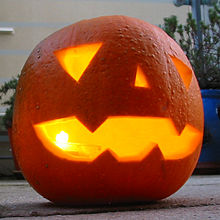
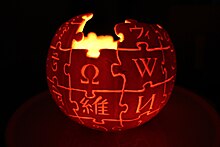
A jack-o'-lantern (or jack o'lantern) is a carved pumpkin or turnip, associated with the holiday of Halloween and named after the phenomenon of a strange light flickering over peat bogs, called will-o'-the-wisp or jack-o'-lantern. In a jack-o'-lantern, the top of the pumpkin or turnip is cut off to form a lid, the inside flesh is scooped out, and an image - usually a monstrous or comical face - is carved out of the rind to expose the hollow interior. To create the lantern effect, a light source is placed within before the lid is closed. Though the light source is traditionally a flame such as a candle or tea light), electric jack-'o-lantern lights featuring various colors and flickering effects are also marketed specifically for this purpose. It is common to see jack-o'-lanterns on doorsteps and otherwise used as decorations prior to and on Halloween.
Etymology
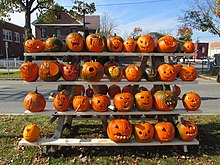
The term jack-o'-lantern was originally used to describe the visual phenomenon ignis fatuus (lit., "foolish fire") known as a will-o'-the-wisp in English folklore. Used especially in East England, its earliest known use dates to the 1660s. The term "will-o'-the-wisp" uses "wisp" (a bundle of sticks or paper sometimes used as a torch) and the proper name "Will": thus, "Will-of-the-torch." The term jack-o'-lantern is of the same construction: "Jack of lantern."
History
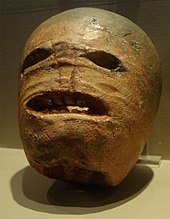
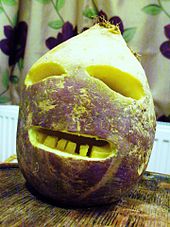
Origin
The carving of vegetables has been a common practice in many parts of the world, and gourds were the earliest plant species domesticated by humans c. 10,000 years ago, primarily for their carving potential. For example, gourds were used to carve lanterns by the Maori over 700 years ago; the Māori word for a gourd also describes a lampshade.
It is believed that the custom of making jack-o'-lanterns at Halloween, from turnips or pumpkins, began in Ireland. In the 19th century, "turnips or mangel wurzels, hollowed out to act as lanterns and often carved with grotesque faces", were used at Halloween in parts of Ireland and the Scottish Highlands. In these Celtic-speaking regions, Halloween was also the festival of Samhain and was seen as a time when supernatural beings (the Aos Sí) and the souls of the dead roamed the earth. The belief that the souls of the dead roamed the earth at Halloween was found in other places, as well.
Jack-o'-lanterns were also made at Halloween in Somerset (see Punkie Night) during the 19th century. Some of those who made the lanterns said they represented the spirits or supernatural beings; some sources suggest that the jack-o'-lanterns originally represented Christian souls in purgatory, as Halloween is the eve of All Saints' Day (1 November)/All Souls' Day (2 November). Others said they were used to ward off evil spirits were set on windowsills to keep harmful spirits out of their home. However, sometimes, they were used by Halloween guisers to frighten people.
At Halloween in 1835, the Dublin Penny Journal carried a lengthy discourse on the legend of "Jack-o'-the-Lantern". In 1837, the Limerick Chronicle refers to a local pub holding a carved gourd competition and presenting a prize to "the best crown of Jack McLantern". The term "McLantern" also appears in an 1841 publication of the same paper.
There is also evidence that turnips were used to carve what was called a "Hoberdy's Lantern" in Worcestershire, England at the end of the 18th century. The folklorist Jabez Allies recalls:
In my juvenile days I remember to have seen peasant boys make, what they called a "Hoberdy's Lantern," by hollowing out a turnip, and cutting eyes, nose, and mouth therein, in the true moon-like style; and having lighted it up by inserting the stump of a candle, they used to place it upon a hedge to frighten unwary travellers in the night.
In North America
Adaptations of Washington Irving's short story "The Legend of Sleepy Hollow" (1820) often depict the Headless Horseman with a pumpkin or jack-o'-lantern in place of his severed head. (In the original story, a shattered pumpkin is discovered next to Ichabod Crane's abandoned hat on the morning after Crane's supposed encounter with the Horseman.)
The application of the term to carved pumpkins in American English is first attested in 1834. The carved pumpkin lantern's association with Halloween is recorded in the 1 November 1866 edition of the Daily News (Kingston, Ontario):
The old time custom of keeping up Hallowe'en was not forgotten last night by the youngsters of the city. They had their maskings and their merry-makings, and perambulated the streets after dark in a way which was no doubt amusing to themselves. There was a great sacrifice of pumpkins from which to make transparent heads and face, lighted up by the unfailing two inches of tallow candle.
James Fenimore Cooper wrote a nautical novel titled The Jack O'lantern (le Feu-Follet), Or the Privateer (1842). The Jack O'lantern was the name of the ship.
Agnes Carr Sage wrote, in the article, Halloween Sports and Customs" (Harper's Young People (1885)::
It is an ancient British custom to light great bonfires (Bone-fire to clear before Winter froze the ground) on Hallowe'en, and carry blazing fagots about on long poles; but in place of this, American boys delight in the funny grinning jack-o'-lanterns made of huge yellow pumpkins with a candle inside.
The poet John Greenleaf Whittier, who was born in Massachusetts in 1807, wrote the poem "The Pumpkin" (1850):
Oh!—fruit loved of boyhood!—the old days recalling,
When wood-grapes were purpling and brown nuts were falling!
When wild, ugly faces we carved in its skin,
Glaring out through the dark with a candle within!
In the United States, the carved pumpkin was first associated with the harvest season in general, long before it became an emblem of Halloween. In 1900, an article on Thanksgiving entertaining recommended a lit jack-o'-lantern as part of the festivities.
Folklore
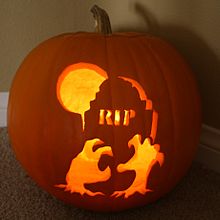

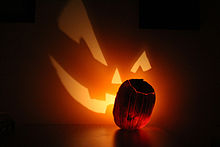
The story of the jack-o'-lantern comes in many variants and is similar to the story of Will-o'-the-wisp retold in different forms across Western Europe, with variations being present in the folklore of Norway, Sweden, England, Ireland, Wales, Germany, Italy and Spain. An old Irish folk tale from the mid-19th Century tells of Stingy Jack, a lazy yet shrewd blacksmith who uses a cross to trap Satan. One story says that Jack tricked Satan into climbing an apple tree, and once he was up there Jack quickly placed crosses around the trunk or carved a cross into the bark, so that Satan couldn't get down.
Another version of the story says that Jack was getting chased by some villagers from whom he had stolen, when he met Satan, who claimed it was time for him to die. However, the thief stalled his death by tempting Satan with a chance to bedevil the church-going villagers chasing him. Jack told Satan to turn into a coin with which he would pay for the stolen goods (Satan could take on any shape he wanted); later, when the coin (Satan) disappeared, the Christian villagers would fight over who had stolen it. The Devil agreed to this plan. He turned himself into a silver coin and jumped into Jack's wallet, only to find himself next to a cross Jack had also picked up in the village. Jack had closed the wallet tight, and the cross stripped the Devil of his powers; and so he was trapped.
In both folktales, Jack only lets Satan go when he agrees never to take his soul. After a while the thief died, as all living things do. Of course, his life had been too sinful for Jack to go to heaven; however, Satan had promised not to take his soul, and so he was barred from hell as well. Jack now had nowhere to go. He asked how he would see where to go, as he had no light, and Satan mockingly tossed him an ember from the flames of Hades, that would never burn out. Jack carved out one of his turnips (which were his favorite food), put the ember inside it, and began endlessly wandering the Earth for a resting place. He became known as "Jack of the Lantern", or jack-o'-lantern.
Cornish folklorist Dr. Thomas Quiller Couch (d. 1884) recorded the use of the term in a rhyme used in Polperro, Cornwall, in conjunction with Joan the Wad, the Cornish version of Will-o'-the-wisp. The people of Polperro regarded them both as pixies. The rhyme goes:
Jack o' the lantern! Joan the wad,
Who tickled the maid and made her mad
Light me home, the weather's bad.
Jack-o-lanterns were also a way of protecting your home against the undead. Superstitious people used them specifically to ward away vampires. They thought this because it was said that the jack-o-lantern's light was a way of identifying vampires and, once their identity was known, they would give up their hunt for you.
In media
- The Grim Adventures of Billy and Mandy Halloween special Billy and Mandy's Jacked-Up Halloween features a completely different if similar version of the above story; Jack was depicted as the village trickster of Endsville long before the series' events. Despite being pleasant, he constantly pulled pranks on the villagers (and was rumored to have invented some tricks, as well as laughing himself to sleep), bad enough to make them send a prank gift to their Queen and frame Jack for it. She in response sent a knight to Jack's home and do away with him. When Grim came to reap him, Jack refused to go and managed to take Grim's scythe, only giving it back in exchange for eternal life. When he was granted it however, Grim, who does not like being tricked, decided to cut Jack's head off to make sure he doesn't bother the villagers anymore. Not long afterwards, Jack had found a pumpkin to use as a new head (giving him the name Jack O' Lantern) though he was shunned from society, forcing him to only come out every Halloween night to play his pranks. Jack is later referenced in the Big Boogey Adventure and also appears as a playable character in the video game.
- In Quest 64, the jack-o'-lantern is an enemy and can be found in Windward Forest. The element is fire for this monster.
- In Bully and Bully: Scholarship Edition, there are 30 jack-o'-lanterns to break to get a jack-o'-lantern hat. They are found Around Bullworth Academy on Halloween mission. If not all of them are destroyed, they can be found in the Bullworth Academy Basement.
- In a Smurfs comic book story, Halloween, the Smurfs' archenemy the evil wizard Gargamel connives with a wicked witch to conjure up Jack himself to get revenge on the Smurflings for pulling some Halloween pranks on them using pumpkin jack-o'-lanterns. Unfortunately, instead of granting their request, Jack insists on carrying away whoever summoned him. When neither Gargamel and the witch will own up to summoning Jack, and try to pin it solely on each other, Jack punishes them both by turning Gargamel into a pumpkin and causing a string of sausages to grow from the witch's nose.
- In Pokémon X and Y, the Ghost Pokémon Pumpkaboo and Gourgeist resemble Jack-o-Lanterns.
- In the Megami Tensei game series, Jack O'Lantern (also called Pyro Jack) is a commonly encountered demon.
- In Gravity Falls the residents of the namesake location celebrate "Summerween" and carve "jack-o'-melons" out of watermelons, and in the episode named after the holiday, The Summerween Trickster threatened to eat Dipper, Mabel, Grenda, Soos, and Candy(the character) if they did not bring him 500 pieces of candy before all the jack-o'-melons extinguished, as the final extinguishing signaled the end of the holiday.
Pumpkin craft


Sections of the pumpkin are cut out to make holes, often depicting a face, which may be either cheerful, scary, or comical. More complex carvings are becoming more common such as: figures, symbols, and logos. A variety of tools can be used to carve and hollow out the gourd, ranging from simple knives and spoons to specialized instruments, typically sold in holiday sections of North American grocery stores. Printed stencils can be used as a guide for increasingly complex designs. After carving, a light source (traditionally a candle) is placed inside the pumpkin and the top is put back into place. The light is normally inserted to illuminate the design from the inside and add an extra measure of spookiness. Sometimes a chimney is carved, too. It is possible to create surprisingly artistic designs, be they simple or intricate in nature.
World records

For a long time, Keene, New Hampshire held the world record for most jack-o'-lanterns carved and lit in one place. The Life is good company teamed up with Camp Sunshine, a camp for children with life-threatening illnesses and their families, to break the record. A record was set on October 21, 2006 when 30,128 jack-o'-lanterns were simultaneously lit on Boston Common. Highwood, Illinois tried to set the record on October 31, 2011 with an unofficial count of 30,919, but did not follow the Guinness regulations so the record did not count. "Highwood sets pumpkin-carving record - Highland Park News". Highlandpark.suntimes.com. Retrieved 2012-10-30. {{cite news}}: Unknown parameter |deadurl= ignored (|url-status= suggested) (help)
On October 19, 2013, Keene, New Hampshire broke the Boston record and became once again the current world record for most lit jack-o'-lanterns on display with 30,581. Keene has now broken the record 8 times since the original attempt.
The world's largest jack-o'-lantern was carved from the then-world's-largest pumpkin on October 31, 2005 in Northern Cambria, Pennsylvania, United States, by Scott Cully. The pumpkin was grown by Larry Checkon and weighed 1,469 lb (666.33 kg) on October 1, 2005 at the Pennsylvania Giant Pumpkin Growers Association Weigh-off.
See also
References
- Harper, Douglas. "Jack o'lantern (n.)". Online Etymology Dictionary. Retrieved 9 May 2013.
- Paris, H.S. (1989). "Historical records, origins, and development of the edible cultivar groups of Cucurbita pepo (Cucurbitaceae)". Economic Botany,. 43 (4): 423–443.
{{cite journal}}: CS1 maint: extra punctuation (link) - "Te Ao Hou". The Maori Magazine. National Library of New Zealand. June 1962. Retrieved October 16, 2013.
- Buse, Jasper; Raututi Taringa (1995). Cook Islands Maori Dictionary. p. 537.
- The Oxford Companion to American Food and Drink. Oxford University Press. 2007. p. 269. Retrieved February 17, 2011.
- "Pumpkins Passions". BBC. October 31, 2005. Retrieved October 19, 2006.They continue to be popular choices today as carved lanterns in Northern England, Scotland, and Northern Ireland; the British purchased a million pumpkins for Hallowe'en in 2004."}}
- "Turnip battles with pumpkin for Hallowe'en". BBC. October 28, 2005. Retrieved September 23, 2007.
- ^ Hutton, Ronald (1996). The Stations of the Sun: A History of the Ritual Year in Britain. Oxford University Press. pp. 382–383.
- Rogers, Nicholas (2003). Halloween: From Pagan Ritual to Party Night. Oxford University Press. p. 57.
- Palmer, Kingsley (1973). Oral folk-tales of Wessex. David & Charles. pp. 87–88.
- ^ Arnold, Bettina (2001-10-31). "Bettina Arnold – Halloween Lecture: Halloween Customs in the Celtic World". Halloween Inaugural Celebration. University of Wisconsin–Milwaukee: Center for Celtic Studies. Retrieved 2007-10-16.
- Palmer, Kingsley (1973). Oral folk-tales of Wessex. David & Charles. pp. 87–88.
- Wilson, David Scofield (1999). Rooted in America: Foodlore of Popular Fruits and Vegetables. University of Tennessee Press. p. 154.
- "History of Jack-o'-the-Lantern". Dublin Penny Journal. 3–4: 229, 1835.
- "Jack-o'-Lantern History". History.com.
- Allies, Jabez (1856). The British, Roman, and Saxon antiquities and folklore of Worcestershire. London: J.R. Smith. p. 423.
- "Jack-o'-lantern". Oxford English Dictionary. The earliest citation is from 1663.
- "Carved pumpkin". Daily News. Kingston, Ontario. November 1, 1866.
- "Review of Cooper's 'Jack O'Lantern'". The Spectator. December 3, 1842.
- Template:Author=Sage, Agnes Carr
- Whittier, John Greenleaf (1885). "The Pumpkin". Poets.org.
- ^ "The Day We Celebrate: Thanksgiving Treated Gastronomically and Socially". The New York Times. November 24, 1895. p. 27.
- "Odd Ornaments for Table". The New York Times. October 21, 1900. p. 12.
- Jack Santino All around the year: holidays and celebrations in American life, p.157 University of Illinois Press, 1995
- Allies, Jabez (1856). The British, Roman, and Saxon antiquities and folklore of Worcestershire. London: J.R. Smith. p. 430.
- Newell, William Wells (1 January 1904). "The Ignis Fatuus, Its Character and Legendary Origin". Journal of American Folk-Lore. 17.
- Mark Hoerrner (2006). "History of the Jack-O-Lantern". buzzle.com. Retrieved 2007-05-09.
- Jacqueline Simpson, Steve Roud, A Dictionary of English Folklore, Oxford University Press, 2000
- Michael Levenson and Kathy McCabe, A love in Common for pumpkins, The Boston Globe, October 22, 2006, p. B6.
- Guinness World Records
- "Largest Jack O'Lantern". Guinness World Records 2009. Archived from the original on 2011-05-18. Retrieved October 10, 2009.
External links
| 🎃Halloween👻 | |||||
|---|---|---|---|---|---|
| Main topics | |||||
| Traditions | |||||
| Food | |||||
| Events | |||||
| Media | |||||
| Related events |
| ||||
| Other events | |||||
| Cucurbita | |||||||
|---|---|---|---|---|---|---|---|
| List of gourds and squashes | |||||||
| Species |  | ||||||
| Cultivars |
| ||||||
| Related topics |
| ||||||